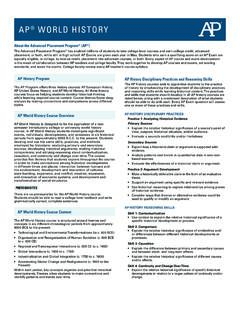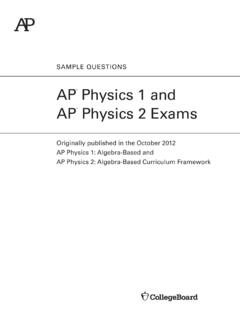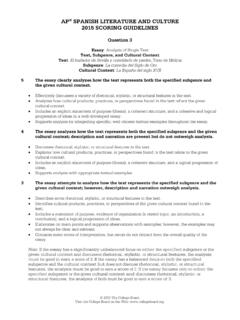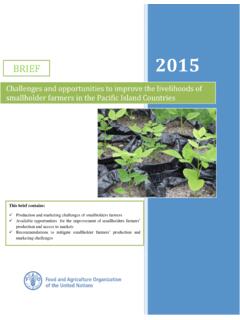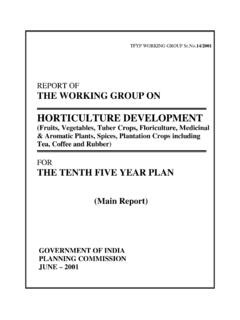Transcription of AP Human Geography 2009 Scoring Guidelines - College Board
1 AP Human Geography 2009 Scoring Guidelines The College Board The College Board is a not-for-profit membership association whose mission is to connect students to College success and opportunity. Founded in 1900, the association is composed of more than 5,600 schools, colleges, universities and other educational organizations. Each year, the College Board serves seven million students and their parents, 23,000 high schools and 3,800 colleges through major programs and services in College readiness, College admissions, guidance, assessment, financial aid, enrollment, and teaching and learning.
2 Among its best-known programs are the SAT , the PSAT/NMSQT and the Advanced Placement Program (AP ). The College Board is committed to the principles of excellence and equity, and that commitment is embodied in all of its programs, services, activities and concerns. 2009 The College Board . College Board , Advanced Placement Program, AP, AP Central, SAT, and the acorn logo are registered trademarks of the College Board . PSAT/NMSQT is a registered trademark of the College Board and National Merit Scholarship Corporation. Permission to use copyrighted College Board materials may be requested online at: Visit the College Board on the Web: AP Central is the official online home for AP teachers: AP Human Geography 2009 Scoring Guidelines 2009 The College Board .
3 All rights reserved. Visit the College Board on the Web: Question 1 The map above shows the distribution of three religious groups in the contiguous United States. Part A (3 points) Using the letters in the legend, name the three religious groups shown on the map. X: Mormon or Latter-Day Saints or LDS 1 point Y: Lutheran 1 point Z: Baptist or Southern Baptist 1 point Part B (4 points: 2 factor points and 2 explanation points) For ONE of the three religious groups, first identify and then explain TWO factors that have influenced the distribution shown on the map. Region X Region Y Region Z Factor 1: Original migration ExplanationFactor 2: Subsequent migration : Mormonism began in the eastern United States, but believers migrated west to Utah, an area outside the authority of those who persecuted them.
4 ExplanationFactor 3: Lack of in-migration : Mormon families grew and migrated throughout the region to farm new areas that could be cultivated in the intermountain West. ExplanationFactor 4: Physical environment : During the 1880 1920 great wave of European immigration, no new immigrants with different religions came to this region because of lack of urbanization. ExplanationFactor 1: Original migration from northern and western Europe : Arid, rigorous climate with lack of water. Explanation: Germans and Scandinavians migrated from Europe in large numbers, bringing with them their religion Lutheranism.
5 ExplanationFactor 2: Lack of later in-migrations of other religions : Railroad companies and state governments recruited these groups to farm. Chain migration occurred as relatives continued to arrive. Explanation: Later groups from Europe (Jewish, Catholic, Orthodox) did not come, as the region lacked the pull of cities. ExplanationFactor 1: Indigenous religion with origins in small towns and rural areas of the southeastern United States : Upper Midwest did not attract rural-to-urban migration from the South during the twentieth century because of the smaller number of cities.
6 Explanation: Baptist religion matured as an indigenous religion in the rural South. Based on Calvinism brought from Europe. No requirement for formally credentialed clergy. Explanation: Baptists appealed to African-Americans excluded from mainline Protestant denominations in the South. Explanationcommunities. : Baptists included other groups that created locally specific church Factor 2: Lack of in-migration Explanation: Other groups of European immigrants with different religions were not attracted to this predominantly agricultural region. AP Human Geography 2009 Scoring Guidelines 2009 The College Board .
7 All rights reserved. Visit the College Board on the Web: Question 1 (continued) Part C (1 point) Explain how the map as presented at this scale is an incomplete representation of the Geography of religion in the United States. Map does not show small areas where other religions dominate. Map does not show areas where density of adherents is really high. Map gives greater importance to small populations. Map masks much diversity and variation in religions. Not able to view subcounty variation. Map overgeneralizes. The following is NOT acceptable to earn the part C point: Excludes Alaska and Hawaii.
8 AP Human Geography 2009 Scoring Guidelines 2009 The College Board . All rights reserved. Visit the College Board on the Web: Question 2 A large proportion of urban residents in the megacities of the periphery of the world system live in squatter settlements. Part A ( 1 point) Describe a typical location of squatter settlements within urban areas of megacities on the global periphery. Edge of city Elsewhere in the built area other than the edge (with explanation) Vacant or undesirable land, such as steep hillsides, floodplains, dumps/landfills, cemeteries, close to industries Land with unclear title Part B ( 2 points) Describe two factors that contribute to the formation of squatter settlements.
9 Large-scale rural-to-urban migration Poverty (with elaboration) Lack of enough affordable housing (public/private) Lack of, or failure to enforce, land use policy (government or private) NOT immigration, unless clearly talking about rural-to-urban migration NOT refugees Part C ( 3 points) Give a detailed account of THREE consequences of the rapid growth of squatter settlements. The three consequences you discuss may be social, economic, political, or environmental. Unhealthy living conditions leading to high morbidity and/or mortality rates in squatter settlements Increase in crime Development of gangs or other nonlegal authority systems that use force to impose their rules Development of political action and/or political unrest Increased water pollution resulting from lack of sanitation facilities and refuse collection Increased soil erosion on hillsides as existing vegetation is removed Decreased air quality resulting from fires used for cooking and heating in settlements Deforestation Visual pollution
10 Increase in the availability of cheap labor Increased risk of disasters, such as fires, industrial accidents, mudslides, flooding Strain on the already inadequate infrastructure such as water, electricity, education, sewer, and fire protection resulting in an increased burden on existing taxpayers AP Human Geography 2009 Scoring Guidelines 2009 The College Board . All rights reserved. Visit the College Board on the Web: Question 3 Agriculture in the United States has changed significantly in the past few decades. With respect to the past, present, and projected trends in agriculture shown in the diagram above, answer the following: Part A ( 4 points) First identify and then explain TWO factors contributing to the steady decline in the number of dairy farms since 1970.
